December 3, 2013 at 7:53 pm
It’s probably not the image you have in your head when you think of salmon spawning, for it is not the majestic leap from pool to pool as a salmon migrates upriver to spawn.
[caption id="attachment_44" align="alignright" width="240"]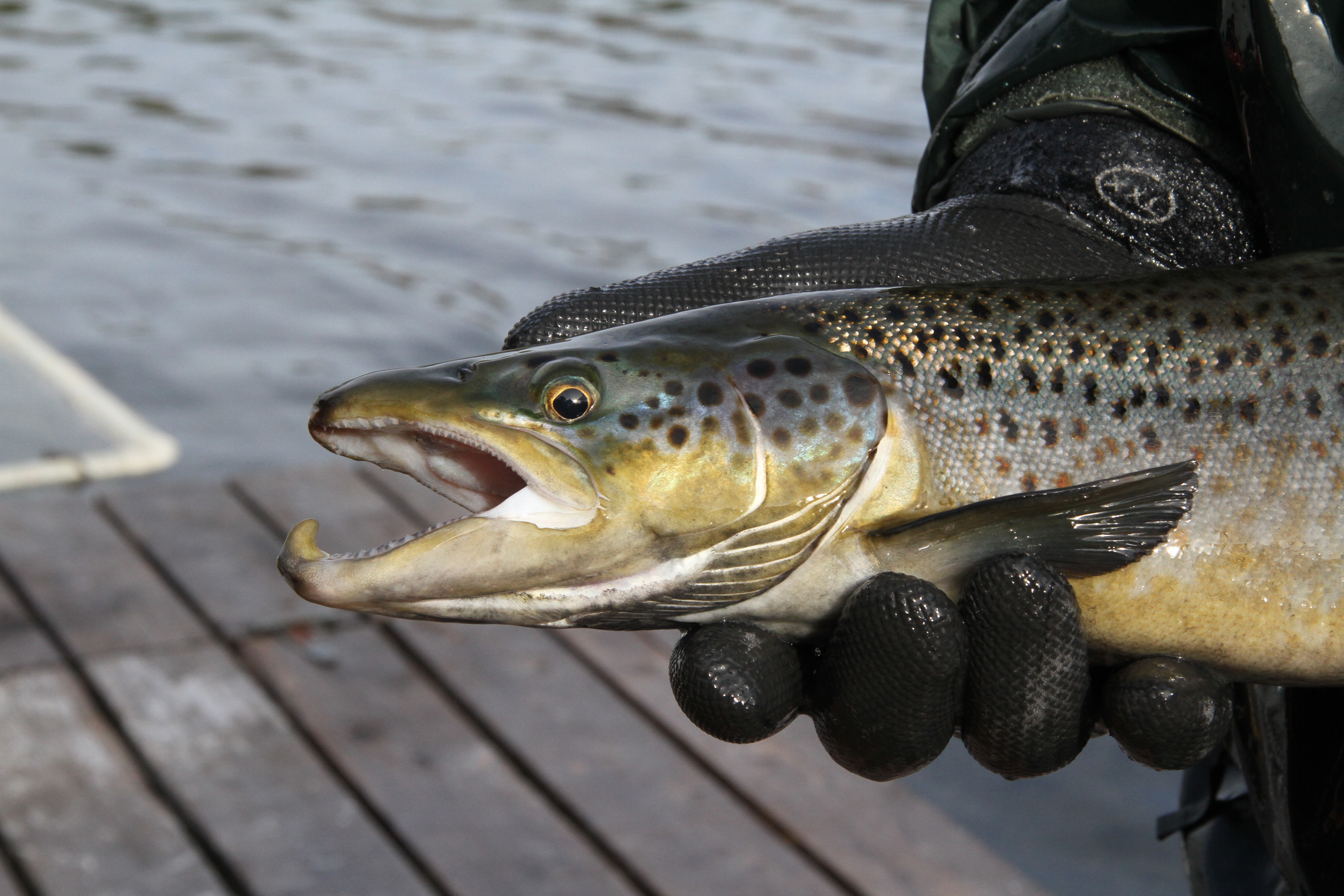 This male landlocked salmon was captured in a trap net and will be "milked" to fertilize salmon eggs.[/caption]
Yet to landlocked salmon anglers who fish Maine’s waterways, this spawning run is critical to the success of landlocked salmon fishing throughout much of the state, even if they do get a little help from Department of Inland Fisheries and Wildlife hatchery staff.
Each year, IFW Hatchery staff trapnet landlocked salmon in order to gather eggs for the hatchery program. West Grand Lake is one of two locations in the state where salmon are collected, then “stripped” of their eggs and milt, and which ultimately are utilized to stock landlocked salmon throughout the state.
Landlocked salmon are native to Maine, but originally, they were only found in four watersheds in the state: the St. Croix which includes Grand Lake Stream in Washington County, the Union River including Green Lake in Hancock County, the Penobscot which includes Sebec Lake in Piscataquis County, and the Presumpscot, including Sebago Lake in Cumberland County.
[caption id="attachment_38" align="alignleft" width="240"]
This male landlocked salmon was captured in a trap net and will be "milked" to fertilize salmon eggs.[/caption]
Yet to landlocked salmon anglers who fish Maine’s waterways, this spawning run is critical to the success of landlocked salmon fishing throughout much of the state, even if they do get a little help from Department of Inland Fisheries and Wildlife hatchery staff.
Each year, IFW Hatchery staff trapnet landlocked salmon in order to gather eggs for the hatchery program. West Grand Lake is one of two locations in the state where salmon are collected, then “stripped” of their eggs and milt, and which ultimately are utilized to stock landlocked salmon throughout the state.
Landlocked salmon are native to Maine, but originally, they were only found in four watersheds in the state: the St. Croix which includes Grand Lake Stream in Washington County, the Union River including Green Lake in Hancock County, the Penobscot which includes Sebec Lake in Piscataquis County, and the Presumpscot, including Sebago Lake in Cumberland County.
[caption id="attachment_38" align="alignleft" width="240"]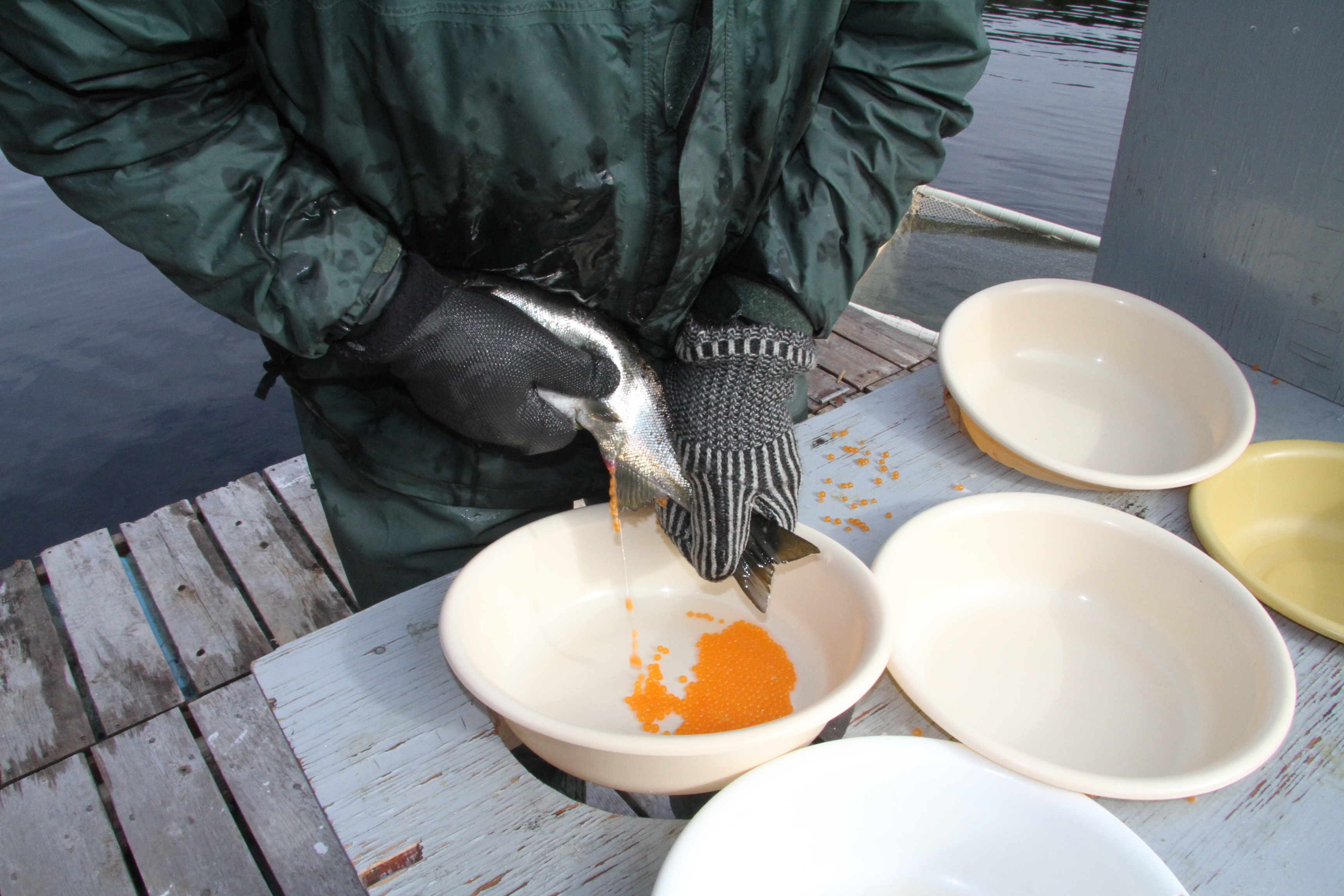 A gentle squeeze helps a ripe, female salmon release her eggs.[/caption]
Landlocked salmon are the same species, salmo salar, as atlantic salmon. As many of you know, the urge to spawn in these fish is extremely strong, and they will go to great lengths to do so.
However, in most lakes and ponds in Maine, there isn’t suitable spawning habitat in order to sustain these fisheries. While the Department and others place a premium on securing and protecting habitat such as Grand Lake Stream, factors such as dams and development limit the amount of spawning habitat available to sustain many coldwater fisheries throughout the state.
That’s why each year in November, a crew of Inland Fisheries and Wildlife personnel gather on West Grand Lake to assist these salmon in spawning.
Like so many other Salmon that migrate to spawning grounds, these landlocked salmon are blocked by a dam. Hatchery staff place a trapnet near the dam where they collect salmon and then place them in pens until they are ripe for spawning.
[caption id="attachment_39" align="alignright" width="270"]
A gentle squeeze helps a ripe, female salmon release her eggs.[/caption]
Landlocked salmon are the same species, salmo salar, as atlantic salmon. As many of you know, the urge to spawn in these fish is extremely strong, and they will go to great lengths to do so.
However, in most lakes and ponds in Maine, there isn’t suitable spawning habitat in order to sustain these fisheries. While the Department and others place a premium on securing and protecting habitat such as Grand Lake Stream, factors such as dams and development limit the amount of spawning habitat available to sustain many coldwater fisheries throughout the state.
That’s why each year in November, a crew of Inland Fisheries and Wildlife personnel gather on West Grand Lake to assist these salmon in spawning.
Like so many other Salmon that migrate to spawning grounds, these landlocked salmon are blocked by a dam. Hatchery staff place a trapnet near the dam where they collect salmon and then place them in pens until they are ripe for spawning.
[caption id="attachment_39" align="alignright" width="270"]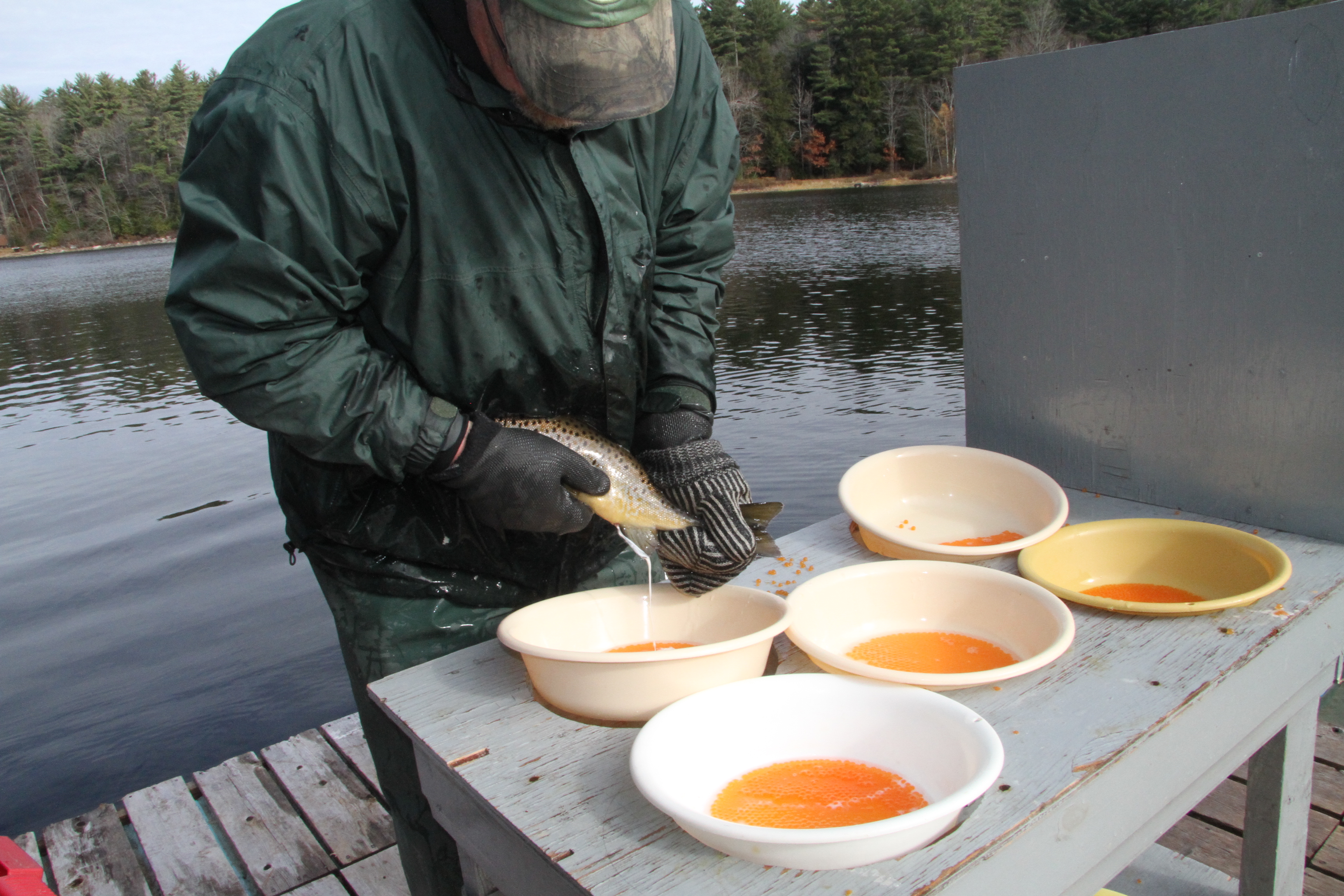 A male salmon's milt is released into a bowl fertilizing salmon eggs.[/caption]
Once the females are “ripe”, a team of state fish culturists assist these salmon in the spawning.
Female salmon are “stripped” of their eggs by massaging and manipulating the fish’s belly, dropping her golden orange eggs into a large plastic bowl. A male salmon is “stripped” of its bright, white milt into the same bowl. The salmon are then released back into the lake.
The eggs and milt are mixed thoroughly in hopes of fertilizing all the eggs, and then allowed to water-harden before being secured for their journey to the hatchery where they will be placed in trays until they are hatched.
Culturists take only a portion of the pair’s fertilized eggs, then take a portion of the next pair’s, and so and so on in order to maintain as wide a genetic diversity as possible. In most years, well over 100 salmon will be stripped. A sample is also inspected and tested by the state’s fish pathologist to in order to protect against disease.
Once these fertilized eggs get to the hatchery, they are placed in egg trays, where the eggs will hatch out into fry later this winter. As they grow, they will be moved to larger tanks and eventually into other hatcheries throughout the state before they are released into the wild, starting at about 18 months from the time the adults spawned.
In the end, those migrating salmon that will have offspring that will populate waterways throughout the state.
[caption id="attachment_40" align="alignleft" width="300"]
A male salmon's milt is released into a bowl fertilizing salmon eggs.[/caption]
Once the females are “ripe”, a team of state fish culturists assist these salmon in the spawning.
Female salmon are “stripped” of their eggs by massaging and manipulating the fish’s belly, dropping her golden orange eggs into a large plastic bowl. A male salmon is “stripped” of its bright, white milt into the same bowl. The salmon are then released back into the lake.
The eggs and milt are mixed thoroughly in hopes of fertilizing all the eggs, and then allowed to water-harden before being secured for their journey to the hatchery where they will be placed in trays until they are hatched.
Culturists take only a portion of the pair’s fertilized eggs, then take a portion of the next pair’s, and so and so on in order to maintain as wide a genetic diversity as possible. In most years, well over 100 salmon will be stripped. A sample is also inspected and tested by the state’s fish pathologist to in order to protect against disease.
Once these fertilized eggs get to the hatchery, they are placed in egg trays, where the eggs will hatch out into fry later this winter. As they grow, they will be moved to larger tanks and eventually into other hatcheries throughout the state before they are released into the wild, starting at about 18 months from the time the adults spawned.
In the end, those migrating salmon that will have offspring that will populate waterways throughout the state.
[caption id="attachment_40" align="alignleft" width="300"]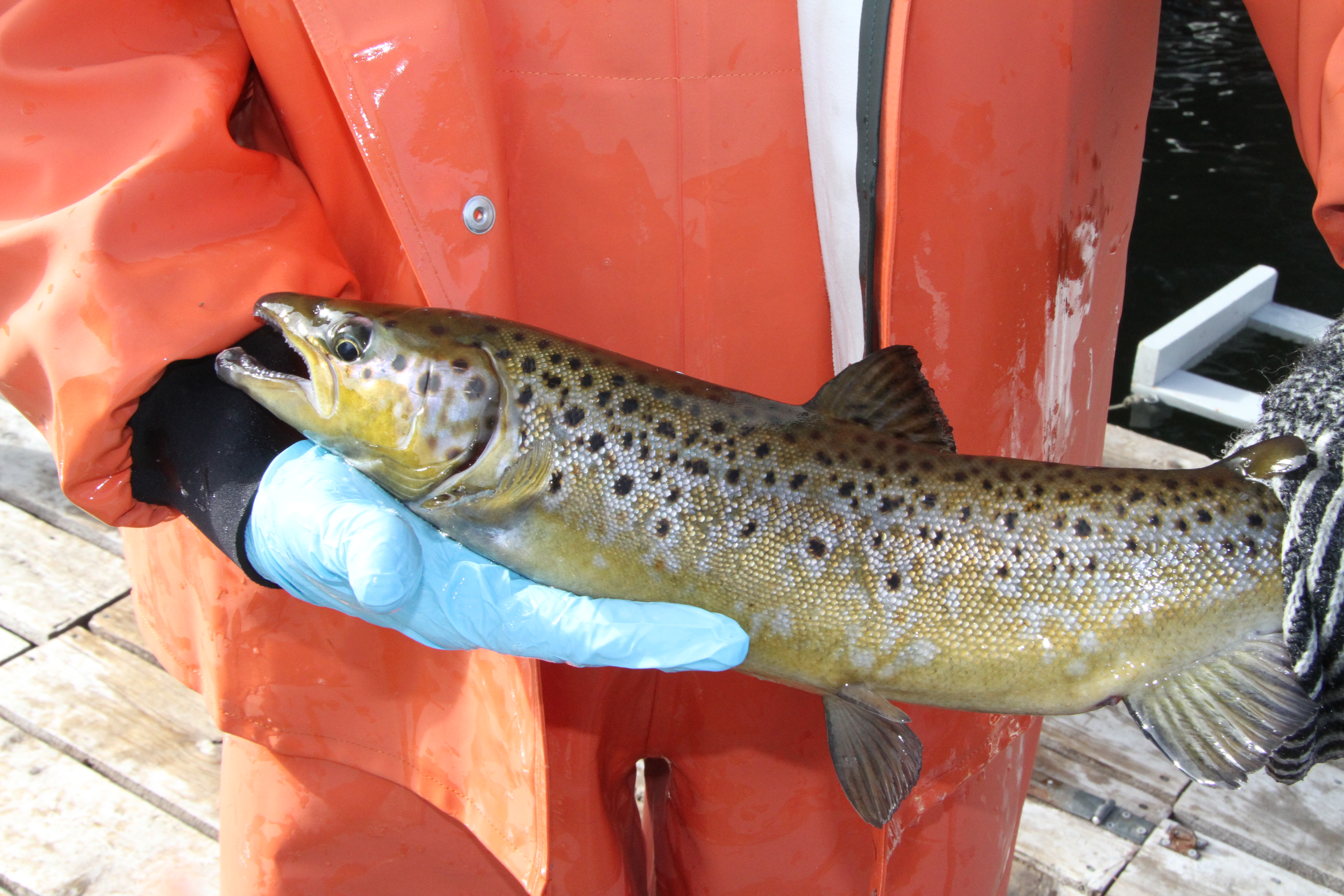 A ripe West Grand Lake salmon.[/caption]
[caption id="attachment_42" align="alignleft" width="300"]
A ripe West Grand Lake salmon.[/caption]
[caption id="attachment_42" align="alignleft" width="300"]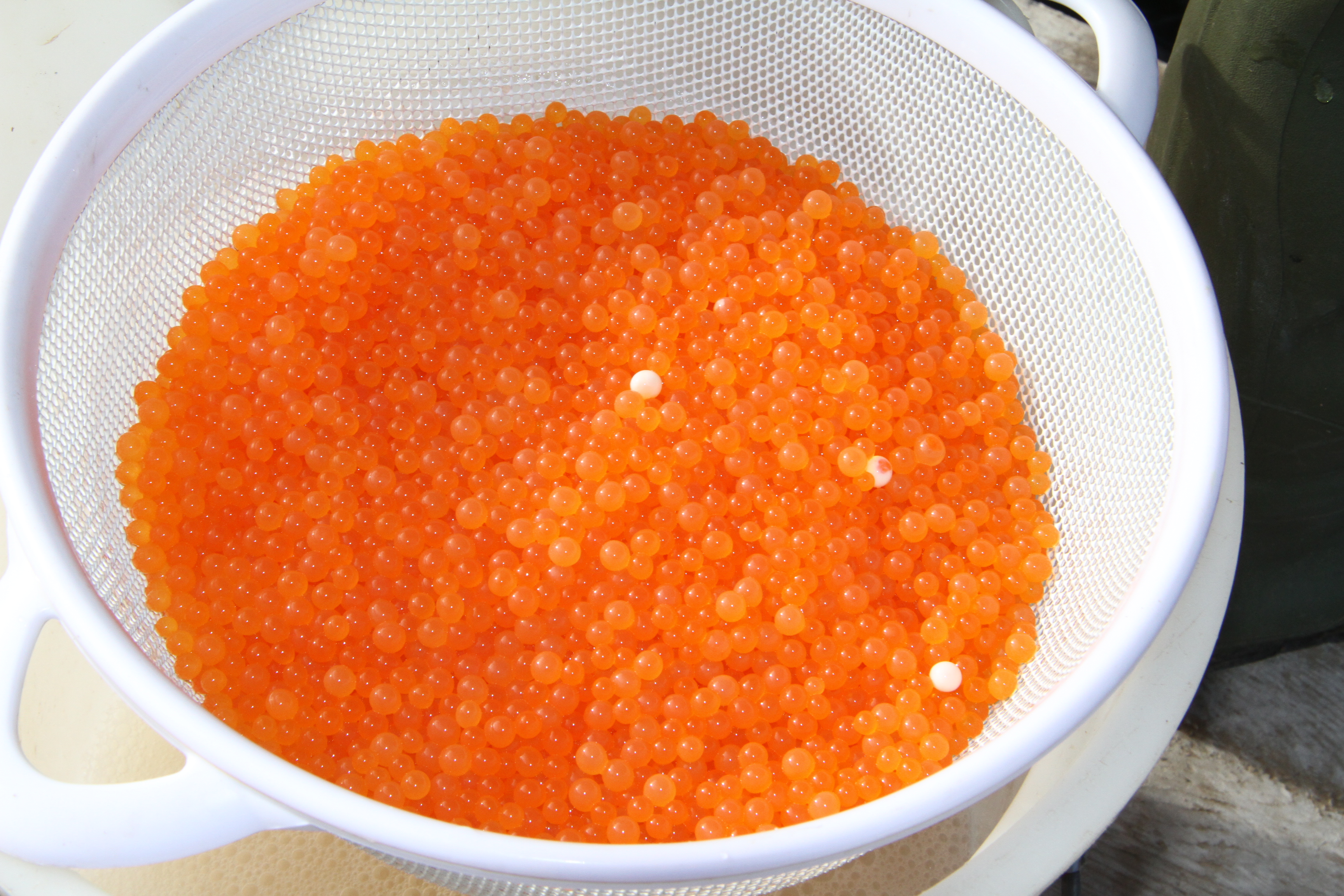 A bowl full of fertilized salmon eggs. The white eggs are "dead" eggs that will be removed before they are brought to the hatchery.[/caption]
[caption id="attachment_37" align="alignleft" width="200"]
A bowl full of fertilized salmon eggs. The white eggs are "dead" eggs that will be removed before they are brought to the hatchery.[/caption]
[caption id="attachment_37" align="alignleft" width="200"]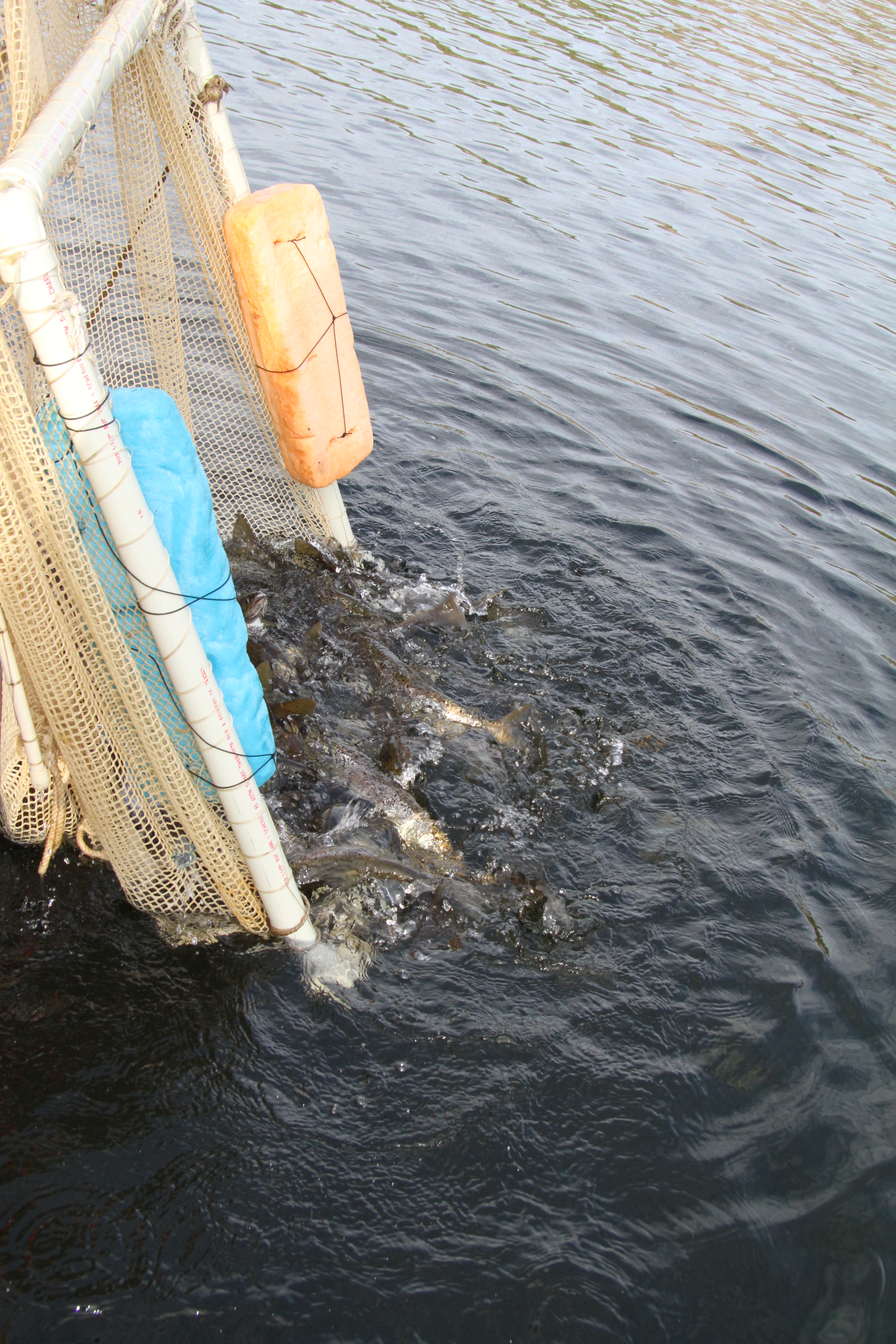 Once the salmon have been stripped of their eggs or milt, they are released back into West Grand Lake.[/caption]
Once the salmon have been stripped of their eggs or milt, they are released back into West Grand Lake.[/caption]
 This male landlocked salmon was captured in a trap net and will be "milked" to fertilize salmon eggs.[/caption]
Yet to landlocked salmon anglers who fish Maine’s waterways, this spawning run is critical to the success of landlocked salmon fishing throughout much of the state, even if they do get a little help from Department of Inland Fisheries and Wildlife hatchery staff.
Each year, IFW Hatchery staff trapnet landlocked salmon in order to gather eggs for the hatchery program. West Grand Lake is one of two locations in the state where salmon are collected, then “stripped” of their eggs and milt, and which ultimately are utilized to stock landlocked salmon throughout the state.
Landlocked salmon are native to Maine, but originally, they were only found in four watersheds in the state: the St. Croix which includes Grand Lake Stream in Washington County, the Union River including Green Lake in Hancock County, the Penobscot which includes Sebec Lake in Piscataquis County, and the Presumpscot, including Sebago Lake in Cumberland County.
[caption id="attachment_38" align="alignleft" width="240"]
This male landlocked salmon was captured in a trap net and will be "milked" to fertilize salmon eggs.[/caption]
Yet to landlocked salmon anglers who fish Maine’s waterways, this spawning run is critical to the success of landlocked salmon fishing throughout much of the state, even if they do get a little help from Department of Inland Fisheries and Wildlife hatchery staff.
Each year, IFW Hatchery staff trapnet landlocked salmon in order to gather eggs for the hatchery program. West Grand Lake is one of two locations in the state where salmon are collected, then “stripped” of their eggs and milt, and which ultimately are utilized to stock landlocked salmon throughout the state.
Landlocked salmon are native to Maine, but originally, they were only found in four watersheds in the state: the St. Croix which includes Grand Lake Stream in Washington County, the Union River including Green Lake in Hancock County, the Penobscot which includes Sebec Lake in Piscataquis County, and the Presumpscot, including Sebago Lake in Cumberland County.
[caption id="attachment_38" align="alignleft" width="240"] A gentle squeeze helps a ripe, female salmon release her eggs.[/caption]
Landlocked salmon are the same species, salmo salar, as atlantic salmon. As many of you know, the urge to spawn in these fish is extremely strong, and they will go to great lengths to do so.
However, in most lakes and ponds in Maine, there isn’t suitable spawning habitat in order to sustain these fisheries. While the Department and others place a premium on securing and protecting habitat such as Grand Lake Stream, factors such as dams and development limit the amount of spawning habitat available to sustain many coldwater fisheries throughout the state.
That’s why each year in November, a crew of Inland Fisheries and Wildlife personnel gather on West Grand Lake to assist these salmon in spawning.
Like so many other Salmon that migrate to spawning grounds, these landlocked salmon are blocked by a dam. Hatchery staff place a trapnet near the dam where they collect salmon and then place them in pens until they are ripe for spawning.
[caption id="attachment_39" align="alignright" width="270"]
A gentle squeeze helps a ripe, female salmon release her eggs.[/caption]
Landlocked salmon are the same species, salmo salar, as atlantic salmon. As many of you know, the urge to spawn in these fish is extremely strong, and they will go to great lengths to do so.
However, in most lakes and ponds in Maine, there isn’t suitable spawning habitat in order to sustain these fisheries. While the Department and others place a premium on securing and protecting habitat such as Grand Lake Stream, factors such as dams and development limit the amount of spawning habitat available to sustain many coldwater fisheries throughout the state.
That’s why each year in November, a crew of Inland Fisheries and Wildlife personnel gather on West Grand Lake to assist these salmon in spawning.
Like so many other Salmon that migrate to spawning grounds, these landlocked salmon are blocked by a dam. Hatchery staff place a trapnet near the dam where they collect salmon and then place them in pens until they are ripe for spawning.
[caption id="attachment_39" align="alignright" width="270"] A male salmon's milt is released into a bowl fertilizing salmon eggs.[/caption]
Once the females are “ripe”, a team of state fish culturists assist these salmon in the spawning.
Female salmon are “stripped” of their eggs by massaging and manipulating the fish’s belly, dropping her golden orange eggs into a large plastic bowl. A male salmon is “stripped” of its bright, white milt into the same bowl. The salmon are then released back into the lake.
The eggs and milt are mixed thoroughly in hopes of fertilizing all the eggs, and then allowed to water-harden before being secured for their journey to the hatchery where they will be placed in trays until they are hatched.
Culturists take only a portion of the pair’s fertilized eggs, then take a portion of the next pair’s, and so and so on in order to maintain as wide a genetic diversity as possible. In most years, well over 100 salmon will be stripped. A sample is also inspected and tested by the state’s fish pathologist to in order to protect against disease.
Once these fertilized eggs get to the hatchery, they are placed in egg trays, where the eggs will hatch out into fry later this winter. As they grow, they will be moved to larger tanks and eventually into other hatcheries throughout the state before they are released into the wild, starting at about 18 months from the time the adults spawned.
In the end, those migrating salmon that will have offspring that will populate waterways throughout the state.
[caption id="attachment_40" align="alignleft" width="300"]
A male salmon's milt is released into a bowl fertilizing salmon eggs.[/caption]
Once the females are “ripe”, a team of state fish culturists assist these salmon in the spawning.
Female salmon are “stripped” of their eggs by massaging and manipulating the fish’s belly, dropping her golden orange eggs into a large plastic bowl. A male salmon is “stripped” of its bright, white milt into the same bowl. The salmon are then released back into the lake.
The eggs and milt are mixed thoroughly in hopes of fertilizing all the eggs, and then allowed to water-harden before being secured for their journey to the hatchery where they will be placed in trays until they are hatched.
Culturists take only a portion of the pair’s fertilized eggs, then take a portion of the next pair’s, and so and so on in order to maintain as wide a genetic diversity as possible. In most years, well over 100 salmon will be stripped. A sample is also inspected and tested by the state’s fish pathologist to in order to protect against disease.
Once these fertilized eggs get to the hatchery, they are placed in egg trays, where the eggs will hatch out into fry later this winter. As they grow, they will be moved to larger tanks and eventually into other hatcheries throughout the state before they are released into the wild, starting at about 18 months from the time the adults spawned.
In the end, those migrating salmon that will have offspring that will populate waterways throughout the state.
[caption id="attachment_40" align="alignleft" width="300"] A ripe West Grand Lake salmon.[/caption]
[caption id="attachment_42" align="alignleft" width="300"]
A ripe West Grand Lake salmon.[/caption]
[caption id="attachment_42" align="alignleft" width="300"] A bowl full of fertilized salmon eggs. The white eggs are "dead" eggs that will be removed before they are brought to the hatchery.[/caption]
[caption id="attachment_37" align="alignleft" width="200"]
A bowl full of fertilized salmon eggs. The white eggs are "dead" eggs that will be removed before they are brought to the hatchery.[/caption]
[caption id="attachment_37" align="alignleft" width="200"] Once the salmon have been stripped of their eggs or milt, they are released back into West Grand Lake.[/caption]
Once the salmon have been stripped of their eggs or milt, they are released back into West Grand Lake.[/caption]Categories